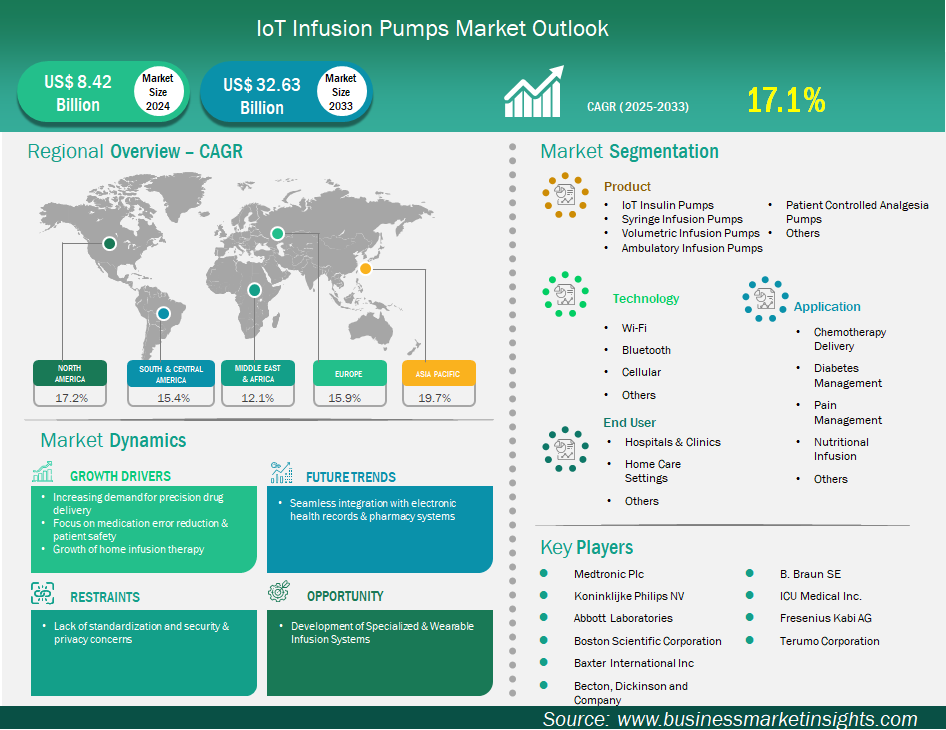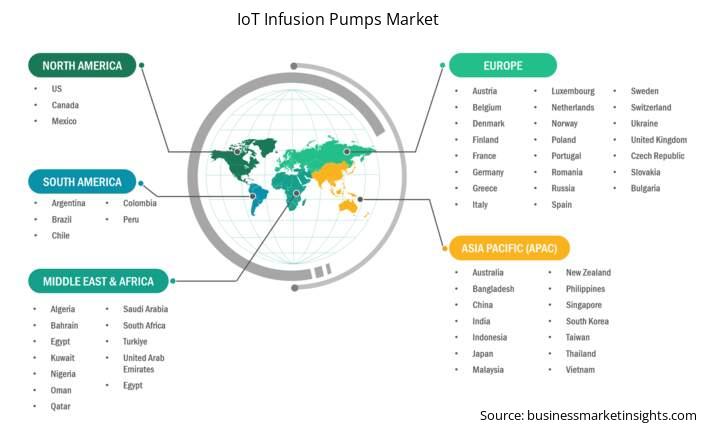IoT Infusion Pumps Market Outlook (2022-2033)
No. of Pages: 200 | Report Code: BMIPUB00031912 | Category: Life Sciences
No. of Pages: 200 | Report Code: BMIPUB00031912 | Category: Life Sciences
The IoT infusion pumps market size is expected to reach US$ 32,633.7 million by 2033 from US$ 8,422.7 million in 2024. The market is estimated to record a CAGR of 17.1% from 2025 to 2033.
The global IoT infusion pumps market is experiencing significant growth driven by increasing demand for precision drug delivery, focus on medication error reduction & patient safety, growth of home infusion therapy. However, the lack of standardization and associated security and privacy concerns are slowing market evolution. Geographically, North America holds the largest share in this market, primarily due to its highly developed healthcare infrastructure that readily embraces cutting-edge medical technologies, strong emphasis on patient safety leading to high adoption rates of smart pumps with advanced features such as Dose Error Reduction Systems (DERS), and favorable regulatory and reimbursement policies that encourage innovation and market penetration. Furthermore, the significant burden of chronic diseases and the increasing trend towards home healthcare in the region also contribute to the demand for portable and user-friendly IoT-enabled infusion pumps. Conversely, the Asia-Pacific (APAC) region is experiencing the fastest growth, propelled by rapidly advancing healthcare infrastructure, particularly in populous emerging economies, increasing disposable income leading to greater healthcare spending, and a growing awareness of modern treatment modalities. Government initiatives and a notable shift towards home-based care models also play a crucial role in accelerating the adoption of IoT infusion pumps across APAC. Key players dominating this market include Baxter International Inc., B. Braun, and Medtronic plc, all of whom are actively investing in product innovation, strategic collaborations, and geographical expansion to solidify their market presence and capitalize on the evolving landscape of smart infusion therapy.
IoT Infusion Pumps Market Strategic Insights

IoT Infusion Pumps Market Segmentation Analysis
Key segments that contributed to the derivation of the IoT Infusion Pumps market analysis are product, technology, application, and end user.
Strongest drivers propelling the IoT infusion pumps market are the demand for precision drug delivery and the increased focus on patient safety and cost effectiveness in drug-related processes. Precision drug delivery systems are increasingly essential, there is now a rapid trend in healthcare towards the delivery of personalized medicine tailored to the needs of individual patients, their genetic make-up, and their real-time physiological response to therapies. Precision drug delivery systems are necessary to ensure the right dose, the right drug, the right process, and the right target site for their treatment within healthcare systems. IoT infusion pumps can reduce this need through the inclusion of functions such as dose error reduction systems (DERS), emergence of automated updates for drug libraries, and programmability for infusions. All of these programmed functions will decrease the use of manual processes, decrease medication waste, and lead to a measurable improvement in therapeutic result and outcome (e.g. the delivery of chemotherapy, pain medications, and even glucose for diabetes management) where small increases or decreases in drug dosage can meaningfully compromise safety or treatment efficacy to patients receiving those medications.
The emergence of specialized and wearable infusion systems represents a promising opportunity for the IoT infusion pumps market. Infusion therapy has already changed drastically and is different than when infusion pumps were large and stationary, and usually only allowed to be used in the hospital, or setting up to the patient mobility, and this often resulted in longer hospital stays. With the current rise in chronic diseases, the growing elderly population, and a clear preference for care at home with patients, there is a clear need and demand for clinical solutions which care for patients. Specialized pumps, in particular, highly portable ambulatory pumps, and inconspicuous wearable patch pumps, enable patients to receive any required medications such as insulin, antibiotics, or pain relief, at home or on the go! The possibility of patient convenience is increased with more possibilities afforded by IoT, which will allow convenient data collection and transmission, remote surveillance by a healthcare provider, automated Bluetooth features to adjust their doses as required, and overall improve adherence to treatment and lower the frequency of clinic visits, which improves quality of life in general. This shift towards having smaller, more convenient, and interconnected infusion devices opens additional pathways for growth in the market space. Wearable infusion pumps, for example, are made for simplicity of use and discretion. Most wearable pumps do away with the IV pole and large infusion devices, as a generalized example, consider the numerous advanced insulin patch pumps, which have Bluetooth connectivity, therefore no longer cumbersome.
The IoT infusion pumps market is classified according to products into IoT insulin pumps, syringe infusion pumps, volumetric infusion pumps, ambulatory infusion pumps, patient-controlled analgesia pumps, and others. The volumetric infusion pumps segment led the market in 2024 and beyond. Volumetric infusion pumps are an integral part of contemporary medical therapy because they are made to provide large, exact volumes of fluid and medications over long periods of time. Their supremacy in the spectrum of infusion devices stems from their near-comprehensive use across all settings in hospitals and clinics, including critical care units, operating rooms, general floors, and emergency departments. They are a necessary tool for providing intravenous fluids, blood products, nutrition, and any number of medications where both total volume and controlled flow rate are essential. Considering the number of people receiving these infusions every day, along with the needed accuracy and ability to incorporate smart features that can help improve patient safety (automatic updates to drug libraries and software for dose error reduction), volumetric pumps will hold onto the largest share within the infusion pump product category for some time.
By technology, the market is segmented into Wi-Fi, Bluetooth, cellular, and others. The Wi-Fi segment held the largest share of the market in 2024. Wi-Fi connectivity is the leading infusion pump category in IoT infusion pumps market share by technology type because it is the technology with the largest share of healthcare facilities and, at least in terms of healthcare facilities, is the more established technology based on infrastructure already in place. While hospitals and clinics do not have substantial amounts of fiber, they do have Wi-Fi — the most appropriate and inexpensive solution for connection that blood for integrating smart medical devices. Wi-Fi will also provide enough bandwidth to handle communication among the significant systems involved in a smart infusion device and account for any real time uploads or downloads.
In terms of applications, the market is segmented into chemotherapy delivery, diabetes management, pain management, nutritional infusion, and others. The chemotherapy delivery segment had the largest market share in 2024. Chemotherapy is the largest application segment for IoT infusion pumps, the level of precision and safety needed when delivering highly potent and often toxic antineoplastic drugs creates significant demand for IoT infusion pumps. Chemotherapy regimens have strong complexity, requiring multiple drug infusions, specific infusion rates, precise duration of infusion, and narrow therapeutic windows - where slight deviations from the prescribed regimen can produce adverse effects or loss of efficacy in the body. IoT-enabled infusion pumps are critical to ensure the delivery of vital medications accurately and controlled. IoT infusion pump products are designed for these most complex patient treatments and deliver more accurate, effective chemotherapeutic therapies while mitigating risks for patients in oncology therapy. Growth in this segment will also be driven by increasing cancer incidence worldwide.
By end user, the market is segmented into hospitals & clinics, home care settings, others. The hospitals & clinics segment held the largest share of the market in 2024. Hospitals and clinics are the largest end-user segment for IoT infusion pumps because these facilities remain points of care where the infusion therapies are delivered at volume and often at the highest level of healthcare complexity. Healthcare facilities address a wide variety of patient populations with an even wider range of medical conditions, utilizing intravenous medications, fluid management, and nutrition.
| Report Attribute | Details |
|---|---|
| Market size in 2024 | US$ 8,422.7 Million |
| Market Size by 2033 | US$ 32,633.7 Million |
| Global CAGR (2025 - 2033) | 17.1% |
| Historical Data | 2022-2023 |
| Forecast period | 2025-2033 |
| Segments Covered |
By Product
|
| Regions and Countries Covered | North America
|
| Market leaders and key company profiles |
|
The "IoT Infusion Pumps Market Size and Forecast (2022–2033)" report provides a detailed analysis of the market covering below areas:

The geographical scope of the IoT infusion pumps market report is divided into five regions: North America, Asia Pacific, Europe, Middle East & Africa, and South & Central America. The IoT Infusion Pumps market in Asia Pacific is expected to grow significantly during the forecast period.
Asia Pacific IoT infusion pumps market includes China, Japan, India, South Korea, Australia, Bangladesh, New Zealand, Philippines, Singapore, Indonesia, Taiwan, Malaysia, Vietnam, and the rest of Asia Pacific. The Asia Pacific region is witnessing the highest growth in the IoT infusion pumps market due to a unique combination of demographic shifts, a growing burden of disease, and considerable improvements in healthcare technology infrastructure and technology adoption.
Within APAC region, specific countries are taking the lead in this pace of growth. China is recognized as the most influential player in this market driven by its huge population, growing chronic disease burden, and government-led push to improve access to healthcare and the quality of healthcare services -- while also emphasizing greater focus on home healthcare. In addition, the strong R&D and growing focus on digital health innovation will continue to drive the adoption of smart infusion pumps. India is also a rapidly expanding market, with a vast pool of chronic condition patients, increased awareness, and investment in improvements to medical infrastructure. The growing number of surgical procedures and a significant shift to treating chronic patients in their homes are major drivers of the demand for IoT infusion pumps in India. Japan, although a mature market, is continuing to see solid growth in the market for IoT infusion pumps, especially for insulin pumps, in response to the high ages population and others driving the demand.
The IoT infusion pumps market is evaluated by gathering qualitative and quantitative data post primary and secondary research, which includes important corporate publications, association data, and databases. A few of the key developments in the IoT Infusion Pumps market are:
The IoT Infusion Pumps Market is valued at US$ 8,422.7 Million in 2024, it is projected to reach US$ 32,633.7 Million by 2033.
As per our report IoT Infusion Pumps Market, the market size is valued at US$ 8,422.7 Million in 2024, projecting it to reach US$ 32,633.7 Million by 2033. This translates to a CAGR of approximately 17.1% during the forecast period.
The IoT Infusion Pumps Market report typically cover these key segments-
The historic period, base year, and forecast period can vary slightly depending on the specific market research report. However, for the IoT Infusion Pumps Market report:
The IoT Infusion Pumps Market is populated by several key players, each contributing to its growth and innovation. Some of the major players include:
The IoT Infusion Pumps Market report is valuable for diverse stakeholders, including:
Essentially, anyone involved in or considering involvement in the IoT Infusion Pumps Market value chain can benefit from the information contained in a comprehensive market report.